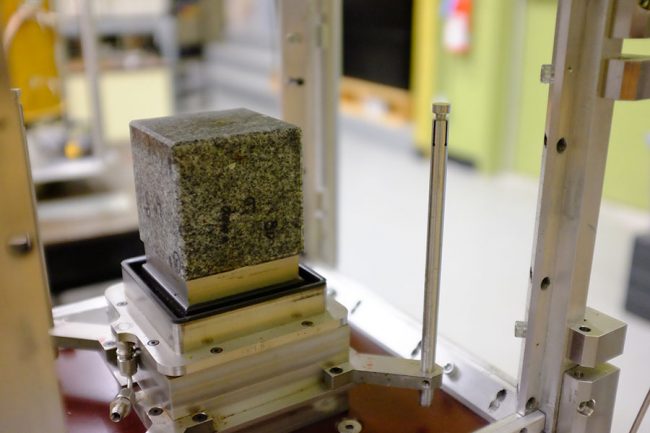CFI’s John R. Evans Leaders Fund will support research into seismicity, water treatment, bioengineering and more.

From hydraulic fracturing (‘fracking’) to enhanced geothermal systems, human activities can impact the ground beneath our feet, and have even been known to induce minor earthquakes. Professor Sebastian Goodfellow (CivMin) knows how to listen for hidden signals that can tell us what is shifting and how.
“Think of the cracking sounds a cube of ice makes when you drop it in a cup of warm water, or the sound a wooden stick makes when you bend it until it breaks,” he says. “This occurs as a consequence of sudden localized changes in stress and we study these microfracture sounds in the lab to understand how rock responds to changes in stress, fluid pressure and temperature.”
The frequency of these sounds is mostly above the human range of hearing, but they can be picked up with acoustic emission (AE) sensors. The challenge is that because scientists can’t predict when they will happen, they have to listen continuously for hours, which leaves them with a lot of data to process.
“We’re talking about more than a terabyte of data per hour,” says Goodfellow. “We use a form of artificial intelligence called machine learning to extract patterns from these large waveform datasets.”

Goodfellow is among nine U of T Engineering professors who have received support from the Canada Foundation for Innovation’s John R. Evans Leaders Fund (CFI JELF), announced today.
His team will use the funding to buy a triaxial geophysical imaging cell fitted with AE sensors as well as hardware for high-frequency acquisition of AE data. This equipment will enable them to carry out controlled experiments in the lab, testing out better algorithms and new techniques to turn the data into insights, and better understand the key processes that lead to induced earthquakes.
By learning more about how these tiny cracks and pops are related to larger seismic events, such as earthquakes, the team hopes to help people in a wide range of positions make better decisions.
That includes people who work in industries that inject things underground —geothermal power, hydraulic fracturing and carbon sequestration, among others — along with those who regulate them.
“Up until now, our poor understanding of the causal links between fluid injection and large, induced earthquakes has limited the economic development of these industries,” says Goodfellow. “Our research will help mitigate the human and environmental impacts, leading to new economic growth opportunities for Canada.”
The other eight U of T Engineering projects funded through CFI JELF are:
- Enabling sustainable e-mobility through intelligent thermal management systems for EVs and infrastructure — Professor Cristina Amon (MIE)
- Kinetics-transport interaction towards deposition of carbon particulates in meso-channel supercritical fuel flows — Professor Swetaprovo Chaudhuri (UTIAS)
- Durable low ice adhesion coatings laboratory — Professor Kevin Golovin (MIE)
- Towards the sustainable development of energy resources: fundamentals & implications of hydraulic fracturing technology — Professor Giovanni Grasselli (CivMin)
- Combination ribonucleic acid treatment technology lab — Professor Omar Khan (BME)
- The Microbiome Engineering Laboratory for Resource Recovery — Professor Christopher Lawson (ChemE)
- The Advanced Membranes (AM) Laboratory for Sustainable Water Management and Resource Recovery — Professor Jay Werber (ChemE)
- Improving collaboration efficiency for fork-based software development — Professor Shurui Zhou (ECE)
“We are very proud of the research programs being put together by our faculty members, especially those at the beginning of their careers,” says Ramin Farnood, U of T Engineering’s Vice-Dean of Research. “This research support will help them continue to make positive, vital contributions to our society and the economy.”
By Fahad Pinto
This story originally published by Engineering News